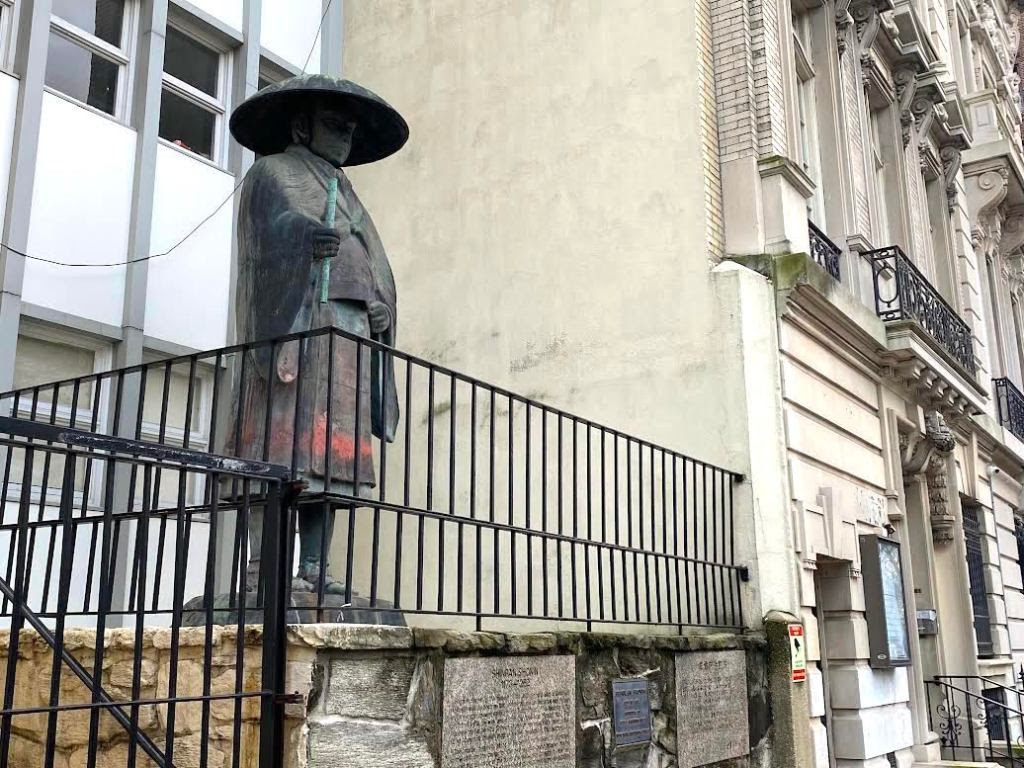Monday, January 10, 2022 – A symbol from the city of Hiroshima


MONDAY, JANUARY 10, 2022
568th Issue
A Bronze Statue that
Survived Hiroshima
has a Message for
Riverside Drive
from Ephemeral New York
What cements Riverside Drive as one of Manhattan’s most beautiful streets is its architecture. The avenue is a winding line of elegant 1920s and 1930s apartment houses, with some surviving rowhouses and a few stand-alone mansions that reflect the beaux-arts design trend of the Gilded Age—lots of limestone, light brick, and marble.

But every so often, the Upper West Side portion of Riverside has a surprise. Case in point is the 15-foot, 22-ton bronze statue that has stood outside 332 Riverside Drive, between 105th and 106th Streets, since 1955, according to Japan Culture NYC. The statue is of Shinran Shonin, a Buddhist monk in Japan who founded a sect of Buddhism called Jodo-Shinshu in the 13th century. The monk is depicted in missionary robes, his face mostly obscured by his hat. (Originally he carried a cane, presumed stolen in the early 1980s, per Japan Culture NYC.)

Photo: Atlas Obscura
Riverside Drive has always been an avenue of grand statues. But how did the statue of a Japanese monk end up here?
The story begins in Japan in 1937, when a businessman in the metal industry commissioned his factories to make six identical bronze statues of Shinran Shonin, according to fascinating research by Sam Neubauer at I Love the Upper West Side. “The statues were spread across Japan, with one standing on top of a hill overlooking Hiroshima,” Neubauer wrote.
Once war broke out, the Japanese military turned three of the statues into scrap metal for ammunition. “A similar attempt was made in Hiroshima but after significant protests over the importance of the statue, the government allowed Shinran Shonin to remain on his hilltop,” stated Neubauer

Riverside Drive between 105th and 106th Street, about 1903
“It was from the hilltop that, on August 6, 1945, the statue witnessed the destruction of Hiroshima when the first atomic bomb exploded over the city,” he continued. “Although the epicenter of the blast was just 1.5 miles away, the statue somehow survived.” An estimated 80,000 people perished in immediate aftermath of the atomic blast.
In 1955, after the New York Buddhist Church moved to Riverside Drive from its original home in a brownstone on 94th Street, the church’s minister and the businessman who commissioned the statue decided to bring it to New York.

MONDAY PHOTO OF THE DAY
Send your answer to:
rooseveltislandhistory@gmail.com

WEEKEND PHOTO OF THE DAY
The rooftop pool at the St. George Hotel in Brooklyn Heights. The pool is long gone but it most have been fabulous!
John Gattuso and M. Frank both got it right!

Sources
Ephemeral New York
Thanks to Bobbie Slonevsky for her dedication to Blackwell’s Almanac and the RIHS
Thanks to Deborah Dorff for maintaining our website
Edited by Melanie Colter and Deborah Dorff
Text by Judith Berdy
FUNDING PROVIDED BY ROOSEVELT ISLAND OPERATING CORPORATION PUBLIC PURPOSE GRANTS CITY COUNCIL REPRESENTATIVE BEN KALLOS DISCRETIONARY FUNDING THRU DYCD


Copyright © 2022 Roosevelt Island Historical Society, All rights reserved.Our mailing address is:
rooseveltislandhistory@gmail.com

Leave a comment